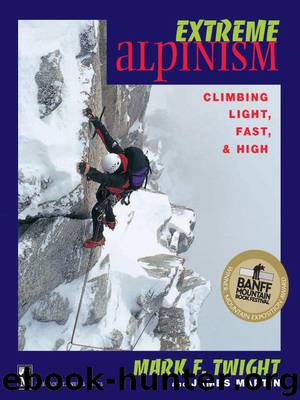Extreme Alpinism by Mark F. Twight & James Martin

Author:Mark F. Twight & James Martin [Twight, Mark F.]
Language: eng
Format: epub
Publisher: The Mountaineers
Published: 2013-01-06T11:00:00+00:00
Ice tools: Choose the lightest ice tools available that can stand up to the abuse of alpine climbing. To be sure, the DMM Predator, at 31 ounces, and the Charlet Moser Quasar, at 30.5 ounces, are extremely durable tools, but they are neither light nor designed with alpinism in mind. On the other hand, a Simond Naja, extremely light (25 ounces) and designed for pure waterfall climbing, breaks too easily for hard-core alpine use. Instead pick a pair of Grivel Geronimos or Rambo 2s or Black Diamond carbon-fiber Black Prophets, which weigh just over 24 ounces each, and put the lightest leash you can find on them.
Crampons: Crampons suffer the same problem as ice tools: the best technical performers are usually the heaviest and least appropriate for alpinism. Look for a pair weighing no more than 32 ounces.
Boots: Replacing standard plastic boot liners with Alveolites or custom liners can save as much as a pound and a half on a pair of boots.
Clothing: Clothing need not be heavy or especially durable for alpine climbing. Rain or wet snow is not a factor at high altitude or in winter, so you may dispense with the Gore-Tex clothing that boasts “Raingear Without Compromise.” Settle for an Activent or microfiber shell system, which is more breathable at less than half the weight (see Chapter 7, Clothing, for suggestions).
Packs: The pack itself may be lightened and simplified to shave off as much as 3 pounds.
Bivy sacks: Obviously a bivy sack will be lighter than a tent and will be better for some routes. But on a route with plenty of tent sites, the tent may result in a lighter load overall because you can carry a lighter sleeping bag. And if you cook inside the tent, stove fuel consumption is reduced.
You can cut weight from a bivy sack if you are reasonably confident you won’t be hit with rain or wet snow. Go for a Gore Dryloft bivy sack; Outdoor Research makes a 13-ounce model. Compare that to even the lightest Gore-Tex model, weighing in at 18 ounces. Single-wall tents are about 30 percent lighter than those with a rain fly and are faster to set up.
Download
This site does not store any files on its server. We only index and link to content provided by other sites. Please contact the content providers to delete copyright contents if any and email us, we'll remove relevant links or contents immediately.
Annapurna by Maurice Herzog(3301)
Into Thin Air by Jon Krakauer(3132)
SAS Survival Handbook by John 'Lofty' Wiseman(2582)
The Ogre by Doug Scott(2506)
Reservoir 13 by Jon McGregor(2147)
Everest the Cruel Way by Joe Tasker(2133)
The End of Eddy by Édouard Louis(2053)
Touching the Void by Joe Simpson(1975)
The Push by Tommy Caldwell(1929)
Iced In by Chris Turney(1853)
The Isle of Mull by Terry Marsh(1806)
Miracle in the Andes by Nando Parrado(1793)
The Call of Everest by Conrad Anker(1788)
Touching the Void (1987) by Joe Simpson(1706)
Mud, Sweat, and Tears by Bear Grylls(1545)
Himalaya Bound by Michael Benanav(1509)
Higher Calling by Max Leonard(1475)
Death Grip by Matt Samet(1383)
Backcountry Bear Basics by Dave Smith(1360)
